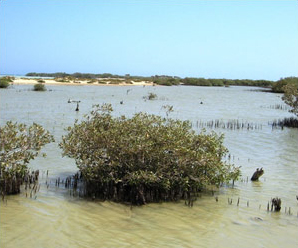Magazine | Voyages
Bons spots égyptiens : les côtes de la Mer Rouge au sud d’El Gouna

Mangroves de Wadi Lahami.Photographie : DR. M. Abdel Razik / Sa galerie sur Panoramio
Introduction
L’Égypte est renommée pour ses vestiges archéologiques, des pyramides au Sphinx en passant par les temples de Karnak, de Philae, ou d’Abou Simbel. Mais outre ces richesses, le pays accueille plusieurs espèces tropicales dont l’Oedicnème du Sénégal, la Rynchée peinte, le Gravelot pâtre, le Coucal du Sénégal ou le Souimanga du Nil. Au total, on peut y observer près de 25 espèces difficiles à voir ailleurs dans le Paléarctique occidental. Outre les espèces sédentaires, de nombreux migrateurs survolent le pays des pharaons sur le trajet entre l’Afrique et l’Eurasie.
Trois observateurs israéliens, Rony Livne, Eyal Shochat et Rami Mizrachi ont parcouru le pays du 11 au 21 septembre 2009, visitant différents spots parfois peu connus autour du delta du Nil, dans les secteurs de Louxor, d’Abou Simbel et le long de la Mer Rouge.
Après le Delta du Nil et les environs de Louxor, nous décrivons le circuit suivi le long de la Mer Rouge, du sud d’El Gouna à la frontière soudanaise.
Abstract
Egypt is renowned for its abundance of archaeological and historical sites. Most people dream of visiting the Great Pyramids and the Sphinx, the Valley of the Kings and the temples at Karnak, Edfu, Kom Ombo, Philae, and Abu Simbel. The country also provides exciting birdwatching, with a number of African species such as Senegal Thick-knee, Greater Painted-snipe, Kittlitz’s Plover, Senegal Coucal, and Nile Valley Sunbird reaching their northern limits here. In fact, there are two dozen species concentrated in this region that are difficult to find elsewhere in the Western Palearctic. And the many migrant birds passing through en route from Africa to Eurasia at this time of year add an extra dimension to the birder’s experience.
Three Israeli birders, Rony Livne, Eyal Shochat and Rami Mizrachi, visited the country from the 11th to the 21st September 2009. They visited several good spots around the Nile Delta, in the area between Louxor and Abu Simbel and the red Sea coasts.
We propose you a french adaptation of their original trip report written in Hebrew . After the Abassa fishponds and the Wadi Natrun, then the Luxor Area, we describe you the spots they visited along the Red Sea coast, from El Gouna to Bir Shalatein, on the Soudanese border.
Poursuivez la lecture de cet article, en vous abonnant dès maintenant !
Découvrez les Archives d’Ornithomedia.com
Pour seulement 10,00 €TTC/an (ou 6,00 € les 6 mois)
Profitez de plusieurs centaines d’articles en accès illimité et sans aucun engagement.
Compléments
À lire aussi sur Ornithomedia.com
- Bons spots égyptiens : les environs de Louxor
- Bons spots égyptiens : Abassa et le Wadi Natrun
- Bons spots égyptiens : autour d’Assouan et d’Abou Simbel
- Bons spots égyptiens : le gebel Elba
Sources
- Rony Livne, Eyal Shochat et Rami Mizrachi (2009). Egypt : 11th – 21 st September 2009. http://www.israbirding.com/reports/birding_reports/egypt_2009_rami/
- PERSGA (2003).Status of bredding seabirds in the Red Sea and Gulf of Aden. PERSGA technical series numéro 8. http://www.persga.org
- AziabMedia. Red Sea facts. http://www.aziab.com/red%20sea%20facts.htm
- Oliva Rama Tours (2008). Egypt : Red Sea specialities. http://www.travellingbirder.com/tripreports/view_birding_tripreport.php?id=388
- Egypt has it all (2008). Marsa Alam, the Latest Spot on the Red Sea Riviera. http://www.egypthasitall.com/blog/category/mangroves/
- Image house. Wadi El Gemal Nationalpark http://www.egyptcd.com/eco_gemal.html
- IBRedSea. Wadi El geaml National Park. http://www.ibredsea.com/hp_joomla_15/en/egypt-parks/wadi-el-gemal
- Richard Bonser (2006). Egypt – Cairo, Luxor and the Red Sea Coast, 18th – 26th March 2006. http://www.birdtours.co.uk/tripreports/egypt/egypt19/egypt-mar-06.htm




Aucun commentaire sur ce sujet
Participer à la discussion !